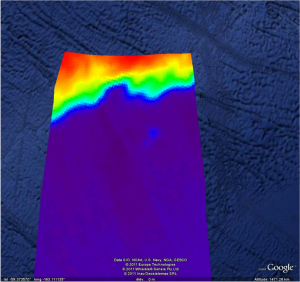Yes, as most of you found out, it is an Iceberg (not that big wrt SMOS resolution, but large never the less)Ewa Slominska gave me the following pictures with the blog post the other day…The Area where the point was travelling looks like this at the time of SMOS over pass closest to the ENVISAT ASAR overpass.
 |
and if we super- impose SAR data we get… |
 |
Bingo! actually zooming a little more we see the iceberg |
 |
It is not that big!More details on this link provided by Serge and Fernando at ESAChttp://www.natice.noaa.gov/pub/iceberg_images/jpeg/2011233_B15J.jpg |

Hello, we would like to plan a ground campaign in conjunction with an SMOS pass over our site ( 29.272060, 47.114960). We can not find data on future passes using EOlisa. We also tried using heavens-above.com, but the pass information does not coincide with historical SMOS passes as seen in EOlisa. Any suggestion on how to get reliable information on this?
Tej, I believe the software you will need to use is ESOV-NG. Unfortunately, I personally have not had a chance to use it, so you would have to play around with it yourself or find someone else experienced with the software to figure out how to determine future SMOS overpasses with it. I believe the basic idea, though, is that you define the orbit of SMOS, define a period of interest, then create a zone including the lat/lon of the area of interest.
hello I thought I answered your question but apparently not!\nWe have used heavens above or orbitron and usually they work pretty nicely, you only have to be aware that they give you the CoG of the satellite and hence the exact field of view is in front.\nWhat I would recommend though is the ESOV-NG tool available for free from ESA (see the tool tab on the blog) It will give you a mucjh more accurate position of the imaged scene\n\nCheers\n\nyann
Thanks for the feedback. I will use the ESOV-NG tool.
Nice to see that the iceberg stands out, like you would expect – though it may appear that the freshwater signal (freshwater lens) has an effect which may be broader in the image?I would also be interested in the extent to which the details of the sea ice margin match what is seen in SMOS?
Hello\n\nSorry for th every long time taken to answer!\n\nI would not bet my saddle and boots on freshwater as the signal will be small especially in cold waters!! It is rather the ice emissivity vs water!\n\nCheers\n\nyann